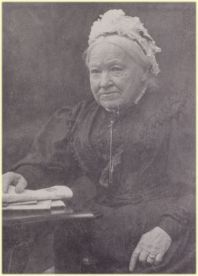Catherine Helen Spence
Catherine Helen Spence was Australia's first woman journalist.
She used this skill in promoting social and political reform
in South Australia. Spence was also a significant influence
in promoting the concept of Federation and her role was
recognised with her image being placed on the Australian
2001 Federation five-dollar note.

Catherine Helen Spence, the daughter of David and Helen
Spence nee Brodie was born at Melrose Scotland on 31 October
1825. On being bankrupted, her lawyer father resolved to
migrate to South Australia and the family arrived on the
Palmyra, landing at Holdfast Bay on Catherine's fourteenth
birthday. By late 1840 her father was Town Clerk of the
Municipal Corporation of Adelaide and the family were living
in Halifax Street.
In 1843 Spence started working as a governess and by the
end of the decade was operating her own school with her
mother and sister, Mary. The Gold Rush era and a lack of
men in the colony may have been a contributing factor in
Mary’s employment as a journalist, but it enabled
her to fulfil a long ambition to be a writer. Catherine
became a published author in 1854 with Clara Morison
- A Tale Of South Australia During The Gold Fever, the first
novel written about Australia by a woman.
The Thomas Hare System of voting being promoted by John
Stuart Mill, the work of Mill’s wife, Harriet Taylor,
promoting votes for women, and the work promoting women’s
rights by Mary Wollstonecraft, instilled a life-long commitment
in electoral reform by Catherine. This work included lecture
tours beyond South Australia. With the approach of Federation
in 1901, she, by now an old woman, worked hard to promote
the concept of federalism and proportional voting schemes.
Catherine was involved in numerous activities and causes
during her lifetime, although she is primarily remembered
as an author and electoral reformer. Her Boarding
Out Society campaigned for foster homes for children
in preference to institutions. In 1897 she was the first
woman appointed to the Colony’s Destitute Board.
She was a recognised Unitarian preacher. Catherine supported
the establishment in 1879 of the first government secondary
school, the Advanced School for Girls. She also worked
to encourage women's access to teacher training colleges
and Universities. She published seven novels, Clara
Morison (1854), Tender and
True (1856), Mr Hogarth's Will (1864),
The Author's Daughter (1868), Handfasted (1880), Gathered
In (1881) and A Week in the Future (1889).
Catherine Helen Spence died at Norwood on 3 April 1910,
leaving an unfinished autobiography that was finished by
Jeanne Foster Young and appeared in serial form in the
Register.
|